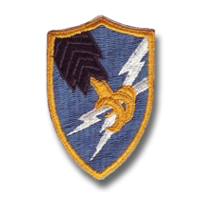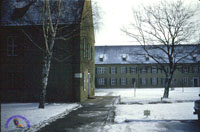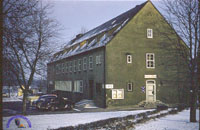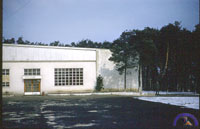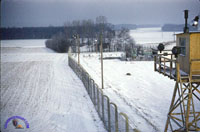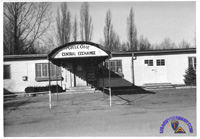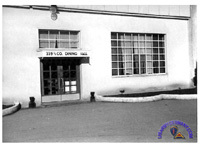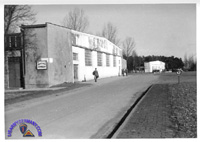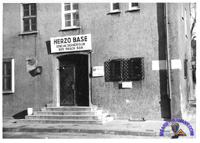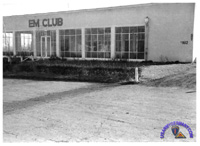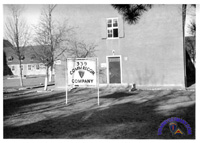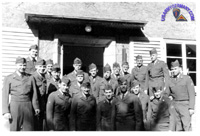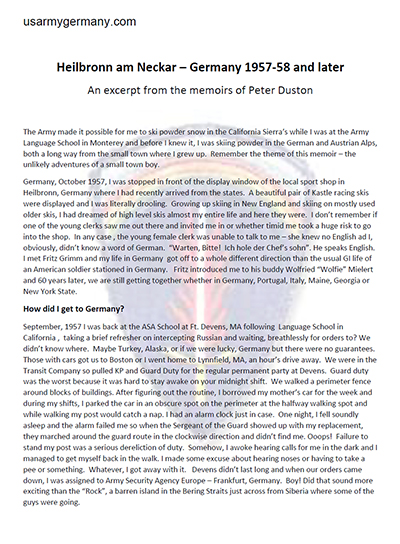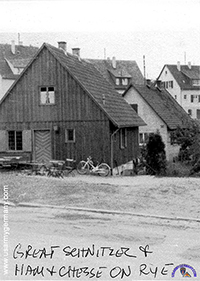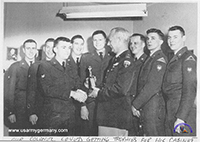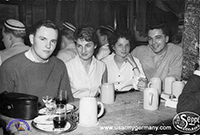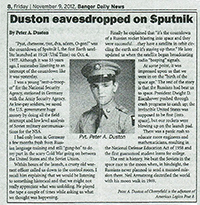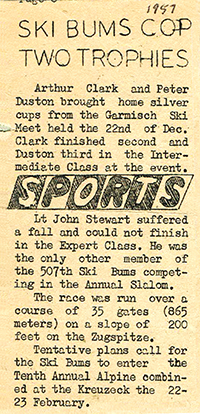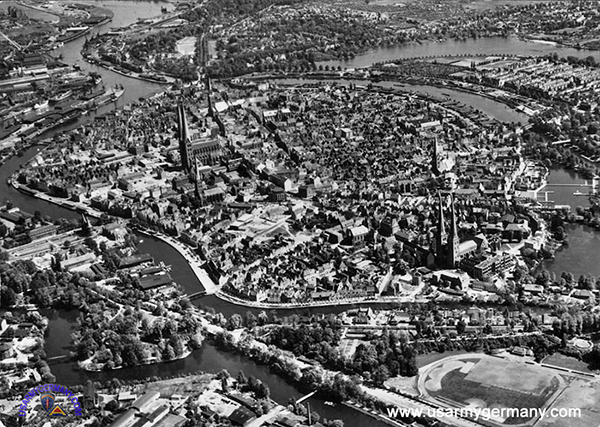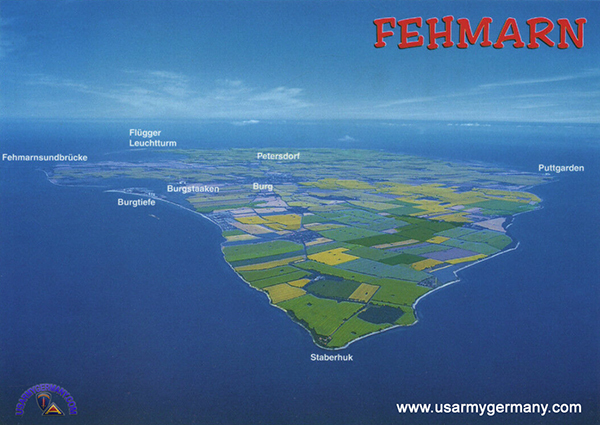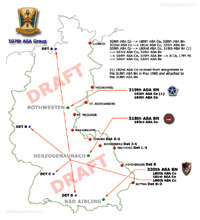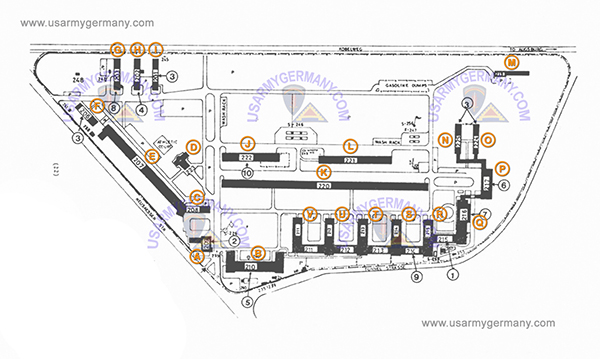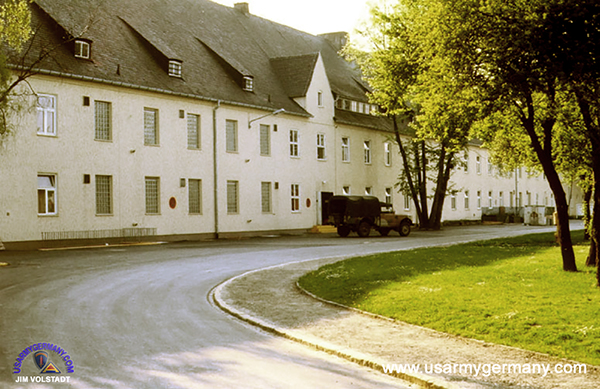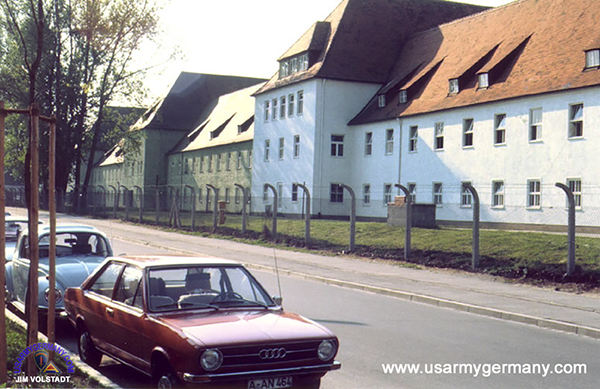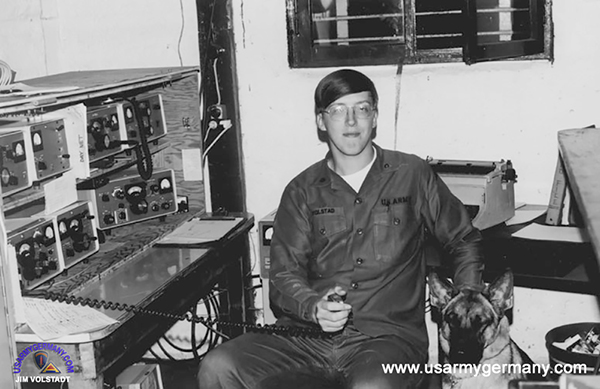| If you do NOT see the Table of Contents frame to the left of this page, then Click here to open 'USArmyGermany' frameset |
||||||||||||||||||
|
Army Security Agency, Europe |
||||||||||||||||||
|
|
||||||||||||||||||
|
||||||||||||||||||
|
|
||||||||||||||||||
| 502nd Communications Reconnaissance Group | ||||||||||||||||||
| 1951 - 1957 | ||||||||||||||||||
| (Source: Various ASA sites including the ASA Vets site) | ||||||||||||||||||
| In
May 1951, HHC, 502nd Communications Reconnaissance
(Comm Rcn) Group was activated
at Ft. Devens, MA. The unit received orders to move to Germany in
June 1952.
Upon arrival in Europe, the Group was assigned
to HQ ASA, Europe and ordered to Badenerhof Kaserne in Heilbronn.
The 502nd was probably further attached to the Seventh Army and assigned
the mission of providing signal intelligence and security support
to the field army and its subordinate units. At this time, the 502d
Group also assumed control of the 302d and 307th Communications Reconnaissance
Battalions which were already in country. In 1952, the 502nd Comm Rcn Gp comprised the following units: |
||||||||||||||||||
|
||||||||||||||||||
| In the mid-50's,
Comm Rcn Bns were involved in the listening role, using TRD-4 DFs
to track movements of equipment such as nuclear weapons systems. During
this period, the 502nd operated detachments at Rothwesten, Tülau
(DF site), Bährdorf (DF site), Söllingen (DF site?) and
several other sites. In late 1956, the Rothwesten and Söllingen dets
were later redeployed to Lüchow and Schöningen. On 1 July 1956, HHC, 502nd CR Gp was redesignated as HHC, 502nd ASA Group as part of a worldwide reorganization of ASA units. (The CR battalions were redesignated as ASA battalions at the same time.) In April 1957, the 502nd ASA Gp comprised the following units: |
||||||||||||||||||
|
||||||||||||||||||
| On 15 October
1957, the 502nd ASA Gp was redesignated as 507th
USASA Gp. Webmaster Note: The 502nd ASA Group had been a TOE (Table of Organization and Equipment) unit while the 507th USASA Group was a TDA (Table of Distribution and Allowance) unit. The underlying reason for the redesignation was in the ASA having been forced to downsize in 1957 after a DoD decision that year to cut the Army's strength by 50,000 personnel. The ASA found itself unable to sustain the manning of its tactical TOE units. In order retain a support structure in the tactical commands, the TOE units were inactivated and replaced by units which were tailored specifically to the needs of their supported command (i.e. mission tailored). These new mission structured units were TDA (Table of Distribution and Allowance) units. The designations of these TDA units also differed from the TOE units they replaced. TOE units were designated as "ASA" whereas TDA units were titled "USASA." |
||||||||||||||||||
| 1955 | ||||||||||||||||||
| (Source: Email from Jack Lee) | ||||||||||||||||||
| The website, your initiative and research in maintaining it are all both admirable and impressive. It is a pleasure to be in touch with you. Herewith my very small contribution, as well as I can recall, after more than a few years. After an unsuccessful first year in college, I enlisted in the Army in 1953 and chose ASA for my assignment. This was contingent upon passing a background investigation, the first of what turned out to be a great many over the years. After basic training at (then) Camp Pickett in VA, I went to Ft.Devens, MA, for ASA testing and assignment. I demonstrated a high aptitude for languages and was told I could, if I wished, attend the (then) Army Language School at the Presidio of Monterey in CA. They then told me I could choose, right then, from among Czech, Serbo-Croatian, Russian and Albanian. In the belief that Russian would offer the best post Army possibilities, I chose that and, for the next forty-six weeks spent six hours a day in class learning to speak, write and read Russian. I had the advantages of liking language study, being fairly fresh from an academic environment, and I did well. Throughout my post Army career, I have studied and used three other languages and Russian remains by far my best second language. Then to Arlington Hall Station for a several week course in Russian language radio intercept and transcription. I arrived in Frankfurt in late Spring or early Summer 1955 and spent a short time in, and I have always remembered the name, Gutleut Kaserne, for ongoing assignment. The scuttlebutt was that there were three possibilities: someplace in Bavaria, nfi, Lubeck in the north where the guys wore civvies and lived in houses, and something called Bahrdorf, where the accommodations consisted of canvas Army squad tents. My number came up for Bahrdorf and off I went to Kassel. You have mentioned Rothwesten, I believe. This Is unknown to me and we referred to only Kassel. Some of my language school classmates were still with me, and one morning we were joined by some strangers and loaded into several deuce and a halfs for a long day of travel. We arrived after dark at what seemed at the time to be deep woods and were told to disembark and carry our bunks, which we had with us, into waiting tents. I chose to spend the night on my bunk in the bed of the 2 and 1/2 and no one complained. The next morning I saw that my new home consisted of a small collection of those tents with some 3/4 ton and 2 1/2s with what I came to know as "huts" affixed to their beds. It was possible to stand up straight in a deuce hut, but not in a 3/4, and my six foot plus frame found both of them cramped, at least initially. The topography was generally flat and we were on the only hill, really only a slight rise above our surroundings. Farm land surrounded on three sides, while on our east was low scrub gradually developing into larger and deeper woods. We were in the then British Zone, about ten km. from the east-west border and we were proscribed ever from straying east of our location. It was not a rule that was difficult to follow. The camp, officially it had to be called a Detachment and I have no recollection of any designation, was still very much under construction. The commanding officer was a first lieutenant and the first sergeant a huge bear of a man. Both worked daily on the continuing construction, along with a fairly large contingent of motor pool guys who, in addition to vehicle maintenance and driving, erected and climbed poles for the antenna array that was also growing. My linguist and other technical buddies were excused from the construction and went immediately to shift work in the huts. When we were off shift we were not expected to do any of the manual labor, but most of us pitched in doing some of the lighter stuff. When we arrived, the latrine consisted of a single wood box with a seat hole placed over a hole in the ground. The women working in the nearby fields found this most amusing and the c/o quickly responded to many complaints and a proper four-holer with sides, roof and door was quickly put together. Each tent had an oil stove that worked fairly well. There was no pecking order in the tents and everyone did his share and I recall no problem of slacking or personal animosity. I suppose we realized we were all in the same situation and that everyone had to pull an oar. Everyone did. I do not remember precisely to what outfit I belonged to. My DD 214 lists Company A, 507th ASA BN (sic), (Webmaster note: could this have been the 307th ASA Bn?). I know that ASA was never used and that the battalion to which I belonged, and it well may have been 507, was called a ComRecon battalion. Same thing, to be sure, but it surely did not say ASA. All R&R, for just about everyone, took place at the Gasthaus zur Eisenbahn, about a kilometer north and down the hill and then one click back east and just across the tracks. The gasthaus was there, but the eisenbahn had not operated since the east-west border was closed. An elderly German couple ran the place. The woman, of course, immediately became "Mutti," and she seemed to appreciate the name. The husband was known as and answered to "Rudy" and, whether was his name or not, I know that Mutti and Rudy are fondly remembered by a lot of now old soldiers from their Bahrdorf days. They served the usual schnitzels, wursts, and brotchen and never, ever ran out of beer. They had quickly adapted to shift work, and I do not recall ever having seen the place closed. There was a mess tent and an adjoining dining tent and there was always something to eat at the end of shift. It was generally OK Army chow, and every week we had a meal of WWII C-rations. Despite our involuntary efforts to reduce the inventory, I suspect there are still plenty of them around. Water for all uses was delivered by tanker and each tent had jerry cans for its own use. Once a week, each shift went by truck to Wolfsburg, home of the VW, to a bathhouse, and that is really what it was and what we really wanted. Several of our group had POVs and we would occasionally go back to Wolfsburg for a truly elegant meal in a fine restaurant. There was also a large public swimming pool in Wolfsburg which we also visited. Sometime in October, we closed the site and returned to Kassel for the winter. We were kept half busy with make work and, as long as we stayed out of trouble, no one seemed to care what we did. I did have the opportunity to go on two separate "patrols." On the first, a small group of us traveled by jeeps and an ops 3/4 to a town I simply do not recall, but it was in the American zone and, no surprise, close to the border. We bunked with a small group of fellow ASAers who lived in a house and very comfortably. They were not happy to see us in our fatigues and boots. There were two German women, in their twenties, who came in every day to clean, do laundry and cook. We went out every morning and drove east to yet another hill, where we set up a small, portable antenna, turned on our radios and searched. We did this every day for about a week and it was a completely dry hole. In the meantime, some of us had become friends with the housekeepers, no doubt further alienating us from our reluctant host who were, I am certain, not at all sorry to see us leave. On yet another "patrol," and my memory is quite vague on this, a small group of us were back in the British zone, staying on a British Army base. We had our own rooms for bunking, ate with the Brits and drank with them in the evenings. Many of us, me included, learned for the first time what it means to be two peoples divided by a common language. I have no idea what we did about ops on that patrol. With most of winter behind us, we returned to Bahrdorf in late Spring 1956. By then, we were old hands and fell right back into the swing of things. Mutti and Rudi were still running the gasthaus and were delighted to see us return. I had been accepted to return to college and the Army gave me an "early out." I left Bahrdorf in early August and was separated from active duty at Ft. Dix later that month. Fast forward to 1992. I was serving at the embassy in Budapest and my wife and I took a driving vacation that included Germany. We went way out of our way to visit Bahrdorf. Our first stop was the gasthaus; it was there, but not open,for the first time in my experience. We drove to the bottom of our hill and noticed large antennas on top. A young German man in civvies stood in the road. We stopped and I explained in my kitchen German who I was and when I had been there before. He was polite and courteous, asked no questions and simply wished a pleasant remainder of our travels. And that, Walter, is the story of my experience in USAREUR Germany. |
||||||||||||||||||
| Visit the bennettpics Online Photos |
||||||||||||||||||
| 334th Communications Reconnaissance / 339th ASA Company | ||||||||||||||||||
| (Source: From some historical information compiled by Ralph R. Thadeus on his ASA Alpiner website) | ||||||||||||||||||
(1) Could it be that the 334th was a National Guard or Army Reserve unit that was "returned" to the States and replaced by a Regular Army unit (in this case the 339th CR Co) under the program described on the Seventh Army Page (Release of RC Units)? |
||||||||||||||||||
| (Source: Email from Roman P Weber, 334th CR Company and 328th CR Company) | ||||||||||||||||||
| August 1951 I was discharged from the USN, Radioman (RM3), morse radio operator aboard ships almost 4 years and last 6 months in Korea. In November I enlisted in the Army. While at Ft Riley for basic I was interviewed by ASA/CIC officers, I believe from Vint Hills Farm Station, Warrenton, VA. Following the "classified interview", I volunteered for ASA. Sent to Vint Hills. TS/Crypto indorsed Clearance approved and went to TSESS, Ft Gordon. Completed the 6 month morse High Speed Operator (MOS 1766) in a few days. Graduated and sent to Ft Devens, MS and assigned to the "newly forming" 334th Comm Recon Co. Trained with an 11-man DF Team for several months. About February 1952, the 334th was stationed at Funari Barracks, Käfertal (Mannheim), Germany. Our shoulder patch was the "Flaming Sword;" brass, "Unassigned (eagle)", although we were permitted to wear any army branch brass we wanted to just so long as our overseas hat braid was the color of the branch. Otherwise hat bread for "unassigned" branch was green. "Green" was the only one issued. If you wanted to wear other branch (Armd, Arty, Inf, etc) brass and hat braid, you had to buy them yourself. Most did that. The 334th, I think, came under the 502nd CR Group. Never heard of the 302nd, 307th, 312th CR Battalions. The only ASA companies I knew of through the earlier 1950s, were the 328th, 332nd and 334th CR Companies. I probably never became familiar with the chain of ASA command, since I was almost always gone from my ASA company with my 11-man DF Team. Maj Kenny, MP, was Company Commander when we first got to Mannheim from Ft Devens, MA. Replaced by Maj Carnine, MP. Neither one could enter "operations", since they did not have, nor need to have, TS/Crypto clearance. My DF Team comprised a SSG, NCOIC (in 1952, E7 was the highest EM grade, 1st Sgts) and 10 Corporals -- five were High Speed Ops (1766) and the other five Intercept Ops. We worked 24/7, two-man shifts, one of each MOS. ALL were cross-trained to the other MOS, although, I think for security reasons, never recorded in Personnel Files. For the first few months in Germany (Mannheim), the DF Teams went TDY to DF Sites of the 332nd CR Co that had already been performing ASA/NSA missions. After HOT with the 332nd a few months, my DF Team was qualified to perform "missions." Our Team moved "all over" W. Germany testing antennas and reception quality/quanity of soviets of their Republics and satellite nations they occupied since the end of WW2. After some months "testing", our Team was more permanently stationed at Sinzig am Rhein und Ahr, a few miles south of Remagen and about 10 miles south of Bonn. After several months at Sinzig, our Team moved back to the Company at Eschwege, near Kassel, where it had moved to from Mannheim. From the back of our van, we could see the E. Zone communist border towers, just a couple kms distant. I was transferred to the 328th CR Co, Bad Aibling, at the foot of the Alps in southern Germany, near Munich and not far from Salzburg, Austria. I was promoted to SP5 (SP2 back then). Sent to a 328th 11-man DF Site at Graz, Austria, near the border of Hungary/Yugoslavia, at a small British Army Intell Kaserne. (International occupation of Austria, Britain, USSR & US, not permitted same as when we were in French Zone, Germay). When packing my suitcase at Aibling before leaving for Graz, the CO personally check each item packed and assured that I carried nothing that could ID me as being an American soldier. Was given a civilian clothing allowance and $77 per month per diem while in Austria (or wherever..) while at Graz. $77 almost matched base pay of an E5 w/8 yrs back then and was tax free. Also, cost to eat 4 meals a day in British mess was only $9 a month. And about all it was worth! Most times we ate "out" in gasthauses. At a "selected location" in the forests of the Alps after leaving Salzburg, the last American Zone camp in the West, we stopped the truck. Changed from fatiques into civilian clothing. From then on, and only if really necessary, used the Black/White w/photo, ID Card, not the regular army ID Card (had but hidden). A 3/4T that followed us took my army clothes back to Aibling for storage. We masked all vehicle US Army, numbers, Star, etc and painted OD over it all. Placed British issued army license plates to the truck (Brit army, at least then, used plates rather than bumper numbers etc as we do). Before leaving for Graz, I was briefed. It included instructions as to what to do in event the Russians attacked while the few of us Americans were hundreds of miles from the US Army in Germany, at Graz. Instructions were that if had to retreat we were not to attempt return to Germany. We were to make our way, "anyway we could, on our own, vehicle or afoot, etc", to the Brenner Pass, in N. Italy Alps. Under no circumstances were we as individuals to permit ourselves to become a POW (won't get into that any deeper..) Went down farther on your ASA Page and read some of he things other ASAE vets wrote. I recall much of what the others have written from the ASA companies I was in (1952-1956). ASA didn't have it's own shoulder patch 1952-56 when I was in it. We wore the "US Forces Europe" "Flaming Sword" shoulder patch. In the 334th CR Company at Mannheim we never were permitted to indicate or say we were "Army Security Agency", nor "Communications Recon." When some guys requested songs on AFN they might say they were calling from 334th "Combat Ranger" CR Company etc. NEVER once did I ever hear those that worked in "operations" (High Speed Morse, RDO Intercept, TFC Analysts, etc) say a word about "on duty" jobs etc. Never. Not even when out drinking, which was most of the off duty time! Someone wrote they had ASA decals etc on vehicles. Guarantee that such was never even dreamed of doing in the 334th nor the 328th CR Companies when I was in both at different times. When we left our trick at operations, the Special Police (MP sort of) gate guards spot-checked that you didn't accidentally carry some little piece of paper that you may have scribbled down some call sign of soviets or satellite countries they occupied. Always, 100%, checked the black and white ASA ID card when entering or leaving operations. Not everyone in ASA had TS/Crypto Clearance. Motor mechanics, cooks, etc didn't need such a clearance any more than any others in the army with those MOS's that didn't work in operations. In the 334 we had an MP major for Co. Cmdr. He couldn't enter operations, since he as most officers don't have, nor need, TS/Crypto clearance. The ASA units I was in, or TDY to, did everything possible not to disclose that we were some sort of Mil Intell army unit. We never 'talked shop" even in our barracks rooms even though operations soldiers had rooms separate from cooks, motor pool, etc unit members. We weren't permitted to write home what our MOS jobs were. Some MOS's were not listed in army MOS job description Pamphlets etc. Once ASA came out with an "ASA" Shoulder patch, the security I knew earlier ASA years, went out the window. The patch says, "I'm a member of ASA/Army Intell"...myself, I think it was a stupid move to "tell the world" whom a soldier of ASA is. We were told that the soviets had the name, rank and serial number of every ASA soldier in Europe. Before going to Graz, at a briefing, they said never to permit yourself to become a POW. In event that the soviets attacked while we few were at Graz, we were not to attempt getting back to Germany, 100s of miles distant, but to make our way, on our own, any way we could to the Brenner Pass, N. Italy and if we made it, to report to the first American commander we met. DF Operations How many DF Teams were in the 334th? Several (I think 334 had 4) in different locations in West Germany - and other places I won't mention. To get a "fix" of where "they" (Threat forces) were at the time, requires you to get at least three "good bearings" (using AN/PDR-1?). "Good" meaning DF bearing accurate within a couple of degrees. Sometimes the bearing swing might be plus or minus 10+ plus degrees. Used if none better from other DF sites, but noted on report not dependably accurate etc. DF Team sites were fairly well fixed. At least for weeks or some months. But not always. My team for example, moved all over West Germany testing reception quantity/quality of signals. Probably our reception reports were filed away by ASAE for possible use in the future. Don't know. Some places were good, others lousy. Sinzig obviously was a "good" reception/DFing site. They kept us there a long time. Months. The site was a few miles out of Sinzig on top of a hill that had been an Italian airfield during WW2, we heard, or so the local Germans told us. (I heard, but don't know for sure, that after our team left, Sinzig became a more permanent ASAE location with more people etc. They built a mess hall and bldgs to house troops, and a bigger detachment of ASA soldiers was assigned. Probably true.) In the French Zone of Germany, although international occupation ageements (France, England, USSR & USA) prohibited soldiers of one nation to be stationed in the zone of another nation. Therefore, we wore civilian clothes (civilian clothes were not allowed in the Army in those days. Get caught and charge might be "intent to go AWOL"). At Sinzig we usually wore fatigues only to work. ASA inspectors almost never came around Sinzig. I don't remember any at all. The WOIC of all 334th DF Teams visited once a month to "inspect" and pay us. (Besides, WO, Mr Whipple, had a fraulein in Sinzig to visit! Heard some years later he died of heart attack in hallway at the Pentagon). Received per diem for board and 2-man rooms at Steineman's Gasthaus in Sinzig. Later we moved to Rheinischer Hof, another Hotel in Sinzing. Although liquor-rations were not authorized other than ranking NCO, each of us Cpls were issued a liquor-ration card. NCOIC, Ralph Newquist (years later heard he became an ASA 1st/Sgt, CA?), monthly dispatched his jeep to the embassy liquor store in Bonn to pick up our liquor rations (in a jeep trailer!). We were paid in cash, mostly D-marks, since no American kaserne, PX etc anywhere nearby. What did a DF Site look like? As I remember, vehicles of a DF Team: a 2½-ton with a hut that contained DF equipment, TS/Crypto documents, our personal M1 rifles w/ammo, basic load of emergency C-Rations, limited spare radio tubes and parts an operator could replace; another 2½-ton troop and equipment carrier; one jeep; one ¾-ton "run around vehicle". Usually we used the ¾-ton to and from the DF site if we lived in a hotel or on a kaserne which was always distant from the DF site and antenna field etc. (As we became friends with some of the German civilians in Sinzig, it was not unusual to use the ¾-ton as a "free" taxi cab to take Germans home from the gasthaus and other not-authorized usage). The ¾-ton was permitted to be used for "recreational purposes", since at Sinzig we didn't have access to kaserne clubs, bowling alleys, army movies, etc. I think our DF site had a 500 gallon gas allowance monthly. But never enforced if more than that needed. We didn't buy German gas, but it came to us in 5-gallon cans. We had a 10kw generator in the trailer that was towed by the DF van. I think the trailoe had 10 gas cans strapped across the back end of it. Plus 5-gallon can on side of trucks or back of the jeep. We had a short, I think, 15' power cable from the DF van to the 10kw in the towed trailer which permitted operating while mobile. I don't remember operating mobile in ASA (did in Signal units later), but we could have if ever would have been needed. Had a long (50' power cable?) from DF van to the 10kw, so when we were set up the noisy generator wasn't near our DF hut. I think the nomenclature of the 10kw was, PE-95, but not certain. I know the 10kw had the same engine as a ¼-ton jeep. Inside the DF hut, some equipment I remember: DF set/rcvr with 360 degree bearing taking scope (AN/PRD-1?). Our DF hut also had a BC-610, 500 watt xmtr. We never used "max" power. One reason for not using "max" was that as you key the big xmtr, a power meter pointer swings up to peak of power tuned. If you used 500 max, the needle pointer would peg the meter every time you keyed. Would risk ruining the meter, plus no need for that much RF power output. Never tuned over 300-350 watts output RF. Often we used "Low" power (a switch). Why permit someone in Moscow hear and DF your xmtr when only communicating shorter distance to Mannheim, for example? Our several DF sites sometimes were very long distances apart, so then you would have to use "High Power" when "tracking/Dfing" some station to the east. The DF site had rather complex antenna systems for intercepting receiver. Long coax connecting to antennas. Sig officers, ASA officers often, too, didn't know much about antennas, coax etc. Once we had an inspecting officer at a DF site. He didn't like the way our long coax didn't have the excess length neatly coiled up, instead of staggered along the ground (always on short wooden stakes at Df sites to keep coax from touching ground/earth). He insisted that the excess coax cable be neatly coiled up and attached to side of the truck. What he didn't realize is that when a coil has RF passing through it, it creates a counter-electromotive force within the coiled cable and reduces reception of signals received. We did what he wanted, but as soon as he left we got rid of he coil. Did we stay at gasthaus or sleep in tents? Never slept in tents. Didn't have any along or that were TO&E to DF teams. Lots of times we stayed in barracks if DF site near to a US kaserne. If so, and they had MPs or CID, we stayed in their barracks. Even then, as most always, DF teams drew per diem. Could eat out or in the army mess hall. Lowest per diem I remember was $77 a month. Most, $110. Good deal back in the days when a Cpl E4 base pay wasn't much more than that. Per diem was tax free and never had to pay that much for food and rooms where ever we were. Small incident when staying in an Armored barracks at Bindlach Kaserne, near to the DF site at Bayreuth. Armored unit gave us one big room to house us 11. DF you always have some just coming off duty, some getting ready to go, and the others on their 3 day break (We worked 6 on and 3 off most times). So the room will be kind of messy. The Armd Col and some senior NCO were inspecting troop rooms. (At the time when 334 first got to Germany, 1952, all promotions in the Army were frozen. No promotions. 334 operations had all Cpls with some being made "acting" buck sgts. Wore sgt bands on arm. In 334, by the way, we had only one Pfc. When the Col came in our room he was shocked. Pissed off at the "mess". People in bed, some in underwear, clothes not hung up in lockers, etc. I remember, just now, the "acting" Sgt of our DF Team wasJoe Greeney, Darnellen, NJ and our NCOIC for a while, including that day. The Col wanted to talk to, and did, to whoever was in charge of this bunch of seemingly to him, "misfits.' He asked Joe what in the hell were the jobs of these soldiers, why they weren't on duty but still in bed, etc. Joe told him that for security reasons he wasn't permitted to answer the Col's questions The Col really go pissed off and had Joe give him the phone numbr of CO, 334. No doubt the Col made a phone call. Don't know what he was TOLD, but he nor anyone else ever came around to our room again. Another thing that happened when at Bindlach/Bayreuth site. In 1952 the Army had mid-night curfew. You could be on 30 days leave, but still had to be off the streets at mid-night. At Bindlach when off duty, including NCOIC Greeney, we'd go out drinking or/and chasing frauliens. Almost never made it through the gate by mid-night and written up, DR Report, by MPs or gate guards. MP station sent DRs to senior person in charge of the DF troops, so Joe Greeney would get them from the Armd Orderly Room. Supposed to send all the DRs (lots of them. Most every night, some) back to the company at Mannheim. Didn't. Shit-canned them all when he got them. Got away with it apparently, because we never heard anything about DRs at the company later. I said DF site operators were not interested in msg texts. Only call-signs. Soviet radio morse call-signs were always number/letter three digits. During several hours on duty, we might intercept many many call signs, but most were not of those assigned to your unit's mission. I'm sure other ASA units all had differing missions and call-signs/soviet commands of interest. (Xmtrs aren't issued to Pfcs. More powerful a xmtr sounds, probably indicated the higher the command. Not necessarily though). I think I wrote that my primary MOS was 1766 High Speed Morse Opr. Original MOS was 052, which changed later to 1766. Both included RTT, but never used RTT much. When mobile, or even mobile-at-halt, reception usually not good enough to copy RTT signals). We mostly all learned the other operator's MOS, Intercept Opr. Always two, one of each MOS, worked DFing. The intercept opr would get a good "mission assigned" call sign, then the 1766 would code with a rapid code means the call sign etc and send it to all other unit DF sites. Within minutes, hopefuly, each site would have sent the site's bearing back to "operations" (Mannheim, Bad Aibling, etc) and there it would be plotted and the "fix" of the soviet xmtr location reported. Each unit was assigned "books" of soviets of interest. At the main unit station many Intercept Oprs were always on duty, "listening" for a book assigned mission call sign. Soviets changed call signs fairly often. We never learned, nor were ever told, the soviet command a call sign belonged to. Intercept was not an easy job, since soviets sent and received on different freqs vs US sending and rcving on same freq. So Intercepts might get only one-end of the "to" and "from" message. Without both ends, intell info not much good. Usually, I think, we got both ends. On a trick were many Intercept Oprs. Each had two receivers and operated split-phone. One receiver in one earphone that stayed on a "special" frequency, just in case that important unit of interest came on the air, which wasn't often. The other earphone used while searching the band for 3-digit call signs. When an operator had a mission assigned call sign picked up, he buzzed the WO trick supervisor. The WO, or maybe an NCO sometimes in place of, would alert intercept operators to look for the other end of the intercepted station. During all this time, the DF sites would also be notified the freq of the other end and get a "fix" on it. Then it would be known exactly where both stations (commands) were located. All DF sites intercepted and tracked the same way, so when I moved from 334 to 328, I could get to work immediately. The only difference being call-sign mission of 328 being other than at 334. Identical equipment, same make up of DF Teams, etc, just in some other location in Europe someplace. I found it very exciting. Especially when getting a call sign "book" not having been heard for a long time. |
||||||||||||||||||
| (Source: Email from Cleve Tarvin, 339th CR Co, 1955-57) | ||||||||||||||||||
| I arrived in Germany in April of 1955 and was sent directly to the 339th CR Co as an 058.0 (old mos 1717). We remained there until early 1957 (I think) when the outfit was moved to Kassel where we stayed until October when we were disbanded and shipped back to Herzo as part of the 319th ASA Battalion.
I was shipped home in December of 1957. As I remember it, our company was fairly small. We had a Lt. for a CO, a W/O for ops, two men in the armory (who we each paid $2 a month to clean our weapons) and a large motor pool staff. Operations had four tricks of about twenty men each. We all worked days, swings and mids, 6-3 6-2 6-3 (6 days, 3 off; then 6 swings, 2 off; then 6 mids and 3 off), so we had a lot of three day passes ! We each had to pay $5 a month to cover paying the people who did KP and the tailor and the guys that cleaned our rooms and showers etc. At Herzo Base we were in a large building on the first floor about 200 yards from the chow hall. Our mission was the Czech border guards and secret police and, of course, general search. At Kassel we were about 50 yards from the snack bar on the main road. Operations was right across the street in a two story building. |
||||||||||||||||||
|
|
||||||||||||||||||
| 507th USASA Group | ||||||||||||||||||
| 1957 - 1971 | ||||||||||||||||||
| (Source: Various ASA sites including the ASA Vets and OV-1 Mohawk Association sites) | ||||||||||||||||||
| The 507th USASA
Group was activated in Oct? 1957. The subordinate elements of the
Group expanded their operational sites to 17
spread throughout Germany. Some of the sites were at Lübeck,
Mount Meissner, Gartow, Gusborn, Schneeberg, St. Andreasberg, Wobeck,
Grünstadt (GuardRail) and many other border sites and locations. An Aviation Section was added (probably to HHC) at this time and equipped with two L-19 and one L-20 fixed-wing aircraft and manned by four pilots and five mechanics. The air section operated out of Heilbronn airfield (Mutlangen?). In March 1959, the 251st USASA Processing Co was added to the Group. During the summer of 1960, HQ 507th USASA Gp and the Processing Co were moved to Baumholder where they occupied the facilities previously used by the 11th USASA Field Station (Faulenberg Kaserne?). (Webmaster Note: The field station at Baumholder did not work out, so the ASA established a field station at Harrogate in England and moved the personnel of the 11th FS to Harrogate between April-May, 1960. Then they moved the 502nd Gp to the old 11th FS facility in Baumholder.) In contrast to Vietnam where airborne COMINT was playing a significant role in the 1960s, there was no need for airborne COMINT assets in Europe where the ASA collected COMINT via a well-established network of fixed Field Stations. However, there was a real need for airborne ELINT. The OV-1A model entered US Army service in 1961 and was deployed with the 7th Army (possibly assigned to SRU 2 in Zweibrücken) in Germany in the summer of 1961. By 1962, the 507th ASA Group was collecting ELINT using the OV-1Mohawk (variously called BATTLEAXE, HOT PIPE and SILVER LANCE) and CV-2A Caribou (called SURE THING or GOFER DELTA). G-2 Air, HQ 7th Army, Stuttgart, coordinated all MOHAWK surveillance missions along the border at that time. In April 1962, the 507th USASA Gp comprised the following units: |
||||||||||||||||||
|
||||||||||||||||||
| In May 1965,
the Signal Research Unit 2 at Zweibrücken was assigned to the 507th.
(Webmaster Note: I believe this is the unit that operated the
OV-1A/C Mohawk (BATTLEAXE) and CV-2A Caribou (SURE THING) ELINT aircraft
that had arrived in theater in 1961/62.) The Group's mission changed in the summer of 1966, with the national-level missions being reassigned to other ASA units in Germany. The Group was to provide field army level support to Seventh Army. This change in mission also resulted in a reduction in strength within the Group. The Air Section was discontinued due to personnel shortages (prob. a result of the heavy demand for pilots in VN). In 1968, the Group was moved from Baumholder to Flak Kaserne in Augsburg. On May 3 1971, the 507th USASA Group was redesignated as 502nd ASA Group. |
||||||||||||||||||
| (Source: Email from Peter Duston) | ||||||||||||||||||
| I can add narrative for the 1956-59 time span for HQ, 507th USASA at Badenerhof Kaserne in Heilbronn. I remember Heilbronn Station. Once in a while, those "spooks" showed up in Tillie's and were always surprised at what the conversations were between some of our guys. Philosophy, History, Politics, Chess. They would want us to repeat and they leaned in - we presumed we were being recorded. More than once, we reported to our HQ or maybe CIC about obvious efforts to compromise us. "My brother always wanted a US Gas Mask. Could you get me one. I'd be willing to pay 50 or a 100 Marks for one. He's just a collector of military stuff." was one I remembered. Do you remember the "Soviet Mission in West Germany"? Russian Officers driving cars with an official plate "snooping" near US Bases? We were suppose to report if we saw them and they weren't allowed to come close to Badenerhof. I remember one day I had courier duty to the airfield on Jaeger Hill with one of our new LT's. He wanted to drive the "deuce" I was driving although wasn't allowed because I was signed with the truck. We're coming down that steep Jaeger Strasse hill and the SMLM Ruski's are on the side of the road, out of their car with a telephoto camera pointed down into the Kaserne. The LT swerves across the road and gets the Russians jumping into the bushes almost hitting a German driving up the hill. I remember the look on the poor German's face as he was almost wiped out by our huge truck. The LT got in trouble over that. The Russians apparently filed a complaint. I apparently got off because I had been ordered by an officer to let him drive. Later in 1961-63, when Martha and I lived in Munich, I worked with CIC/FBI/CIA people. Many of them got their start in Army Intelligence and had Reserve commissions - were in my Reserve unit there and when I worked for Radio Liberty, we communicated since RL was financed by the CIA and "other" federal agencies. While at Heilbronn, we had a teenage social club of Germans and a few Americans - the Donnerstag Abend Klub (Thursday Evening Club). We met in the Passagen Cafe, chatted, went on hikes, picnics, dances, etc. We are meeting this year in NY State although one German couple may not make it. We also have had a reunion group of German friends and GI's from back then that has been meeting for 60 years. My wife and I have been back to Heilbronn multiple times. Badenerhof is gone - it was prime real estate and is a nice eco-friendly development now. |
||||||||||||||||||
|
||||||||||||||||||
| Lübeck Convoy – 1958 TDY at the “best” duty in the whole ASA – Co. B, 319th ASAs In late summer 1958, things were quiet at Badenerhof Kaserne where I was stationed with the 507th ASA in Heilbronn. It must've been a lull in the Cold War. A notice went up on the board calling for volunteers to drive some trucks to northern Germany to help set up a new intercept site. The ASA in Europe was tasked with intercepting Russian and East Bloc communications to determine if the Soviet Union was preparing for their invasion of Western Europe, Being somewhat bored, I volunteered. Problem was, you needed a military truck license which I did not have, but no problem, the motor sergeant just signed me off. He said you can learn on the way. Believe me, driving a huge truck through narrow German village streets was nerve wracking but I learned under fire. We were assigned three brand-new deuce and a half trucks. That's a 2 1/2 ton truck, standard with the U.S. Army. We loaded a few cases of C rations in the back since they were unable to give us any advanced travel pay for food on the way. It was unsure how long we would be gone as it wasn't really clear about what our mission was other than to get these trucks up to northern Germany. We got some last-minute orders that directed us to a military base outside of Frankfurt Germany where they loaded our trucks with perforated steel planking (PSP - aka Marston Mats) 1.) , a kind of big metal sheets that clipped together you could lay on a muddy ground and provide a stable foundation for either of landing strip or in this case intercept huts. One of us got a generator trailer to tow as well. There were six of us with one of us being a sergeant in charge, two soldiers assigned to each truck. We had a night in Frankfurt so went on the town. We ended up in a nightclub that offered a strip show on the stage and I experienced my first cross-dressed male playing a woman's role. I was young and kind of naïve about those things so was really shocked when the stripper whipped off her clothes to reveal a male underneath. We continued on into northern Germany which at that time was considered the British Zone, no American army up there. At one location, we were stopped at a Gasthaus and sitting outside eating and having a beer when a British convoy rolled by with hoots: “Bloody Yanks” – taking over everywhere. I don't know whose idea it was, probably our sergeant with a little more experience than the rest of us and wanted to make it a joke but he drove us through Hamburg and down the famous "Reeperbahn" where all the worker prostitutes in the brothels were hanging out the windows waving. We honked our horns and waved as three huge Army trucks drove down through that red light district past the big signs warning allied troops that the area was “Off Limits.” We eventually made it to Lübeck which was our initial destination We had directions to the U.S. Army Station Luebeck but as we're driving down a wide boulevard with mansions on one side and lawns reaching down to the bay, I remarked this couldn't be where there's a U.S. Army station This looks like the high rent district. But then, there they were - a couple of U.S. Army jeeps and several little Austin Healey Sprite sports cars parked in front of a large mansion with a big iron fence gate. We were tired and smelly from several days on the road and trucks and glad to be there and even more amazed as I walked up the walkway and the French windows on the front were open and a young woman sitting in the window welcoming us with "come on in guys, you're just in time for happy hour". I'm thinking, what kind of Army station is this? Well, it turns out that Jürgen-Wullenwever Strasse was leased by the US Army and run like a college fraternity. “Jerk Haus,” as they called it, had their own house mother who cleaned and cooked for them. They had a bar and even a sailboat on the bay down at the end of the lawn. They kept telling us don't tell anybody back in southern Germany what the station is like because we have got the sweetest deal in the whole U.S. Army Europe. Officially, they were a detachment of Company B, 319th ASA Battalion, located in Rothwesten on an old Fliegerhorst (WWII German Air Base). By the way there were several attractive young women at happy hour including the young woman in the window who happened to be the city police chief's daughter. They put us up for the night and I think the next day took us down to the bay where their favorite club was named "Der Kahn" (the Riverboat). It had been a substantial passenger vessel now permanently moored at the dock. The middle decks had been cut out of it so around the periphery were like balconies looking down on the middle dance floor in the bottom of the vessel with the band was. Great jazz and dance music and we had a great time. We stayed a couple of days to get destination orders on where we were hauling the cargo. We got back on the road and headed north to the North Sea coast where we met up with a ferryboat, loaded our trucks for the transport across to Fehmarn Island (GOOGLE Maps) not far off the coast and very close to the East German border. Fehmarn was a summer resort island with beautiful beaches and very popular with Germans and nearby Danes and Swedes. We rendezvoused at George's Gasthaus on the remote end of the island. Here we were to stay for several days while waiting for additional troops who would be setting up an intercept site to monitor Russian communications, especially targeting Rostock which was a huge Russian Navy base. Since we had several days to kill, we stalked the beaches especially ogling the multiple Scandinavian blondes. Too many of them however, had mothers with them who were giving us the evil eye. We had a black sergeant with us from Luebeck who attracted an enormous attention because none of these people had ever seen a black person before. When we walked the beaches, little kids especially, followed Sgt. Clark and he was really great with them. Way down at the end of one beach there was a nude beach which of course we had to crash but with Roy Clark with us it was obvious we were strangers. |
||||||||||||||||||
| Eventually, the intercept team showed up with a communications shelter that fit on the back of a deuce and a half. So we were relieved and headed back south with our three trucks after an overnight stop back in Luebeck. We pretty much drove straight through to Rothwestern in central Germany where we had an intercept base for the central region of the border and was the Headquarters for the Lübeck Detachment. We had some trouble turning our trucks over to the motor Sgt. there. The days we were driving, up and back, we had very little money for food so we were forced to eat the Army C rations that we had with us. Because the cans were cold I had the bright idea of resting them on the manifold of the truck allowing the heat to heat them up. However, I left a couple of cans of beans on too long. They exploded and made an awful mess of that brand-new engine. Somewhere else we had caught the canvas on the truck on a tree branch or tree limb and ripped half of it off and there were a few other issues as well. Eventually, they were satisfied and signed off the paperwork but when they backed one of the trucks into a garage building which had been a hanger of the German Luftwaffe during World War II, there was an explosive mine still in the wall and it blew the back end of the truck off. Luckily no one was hurt. They issued us train tickets and drove us to the train station where we found that we had first-class tickets which was a good thing because in our smelly uniforms we didn't have to sit in second class with other passengers who would've been offended by our presence. Problem was we still had no money for food on this train. We did, however, still had a few C rations so there we were while the steward was going down the corridor with his little gong calling everyone to dinner in the dining car, we were sitting in our first-class compartment opening cans of beans. We got a lot of very disapproving looks but we had had quite the adventure. By the way, while we're on the ferryboat, the other passengers did not believe that we were even Americans. They had not seen any if any since the war so they were convinced that we must be from the Danish Army which was right across the bay. 1.) Primarily used for the rapid construction of temporary runways and landing strips. |
||||||||||||||||||
| Early 1960s | ||||||||||||||||||
|
||||||||||||||||||
| 1960 | ||||||||||||||||||
| (Source: Email from John O'Neil) | ||||||||||||||||||
| My next duty station (after Vint Hill Farms) was with the 507th USASA Group (Field Army) at Heilbronn am Neckar. We had 4 -2½ ton trucks with expandable sides that held all our IBM equipment that ran off portable diesel generators (one per truck). The vans were housed in a big garage and it was a fairly comfortable, if sometimes very cold, arrangement. Being 6 foot 6 and working is a space with a 6 foot roof became a real pain in the neck. Heilbronn was a good duty town because there were so few US military around. I was there from Feb 1960 to May 1961 when we hitched the generators to our trucks and moved to Baumholder. I’ve managed to blot out almost everything about the 5 ½ months we spent there – but I do recall that there was a Sgt Elvis P reported to be driving a tank around in the neighborhood. I have a copy of an order sending me from Heilbronn to Rothwesten for a 4 day TDY on 24 Feb 1961. I have no memory of it, or why I would have gone – unless it was trouble shooting the equipment. I do recall going down to Bad Aibling to deliver a part they needed. They stopped me at the gate, took the part, and sent me home again. Not even a coffee or beer! While working in Heilbronn I received a phone call from a 206 at one of our other Processing Companies saying that an IG Inspection team had just been through his unit, and looked under the covers of one of the machines. When the IG found a rather big mess of old oil and card dust he demanded to know why it wasn’t nice and clean. The 206 quickly explained that it was IBM’s policy ‘not to disturb the dirt’. As much as he would have liked to clean it up, he had to follow IBM’s maintenance orders. He suggested that if my machines were clean, I’d better get them dirty before the IG arrived. Another rather odd practice that we had was called ‘blanket sorting’. Our CO needed sets of random numbers, and one thing that was difficult to do on a card sorter was to produce something random. So we punched up 4,000 cards in sequence, dumped them out on a blanket and them tossed them up in the air several times to get them well mixed up. Needles to say, the cards went every where in the garage; they were ‘sorted’ with gusto. I never knew if it was a true coincidence or if our CO had set us up, but the base commander, a bird colonel as I recall, knocked on the door just after the last big toss. It was rather difficult to explain why the cards were all over the floor. I have no knowledge of any fixed wing aircraft in Heilbronn during my time there. However, being the ASA, I didn’t have any particular need to know! In Nov 1961 I was sent to the 251st USASA Processing Company, Frankfurt (yes - the IG Farben Building) only we were on the 1st floor as I recall. I was still working as a 206 and some how had become a SP-6 (E6). I was in Frankfurt until August 1962 when my second tour was over and I was ready to get out. While I was with the 251st they received an IBM 1401 computer (could have been 1410 but I don’t think so). It was the first computer I’d seen outside the IBM plant in Endicott NY. It had been shipped from the US without ever having been mated on the floor (the RAM came from California and the rest from NY). It took several weeks for the trained IBM techs to figure out why it turned itself OFF every time the power was turned ON. That was my introduction to computers. Jim Campbell in his email said “(When I was in, no 206 had ever re-enlisted - IBM had a job ready for them when they got out.)” When I got out I went to the IBM office in San Francisco, showed them my diploma with TJ Watson’s signature and asked for a job, they asked me what I knew about computers, so I told them I’d seen one in Germany. I got the hint when they said ‘Goodbye, thanks for stopping in”. Late in 1962 was not the time to look for a job repairing the soon to be obsolete IBM punched card machines! It all turned out for the best. I worked as a tab operator while I taught myself computer programming and all that stuff and lived happily ever after. My wife, our three children and I moved to Australia 40 years ago. I’ve enjoyed looking through the web pages. It brings back the old memories of a different era. |
||||||||||||||||||
| (Source: Email from James "Bull" Durham) | ||||||||||||||||||
| I was stationed at Heilbronn from about April/May of 1960 in the 507th USASA GP. I worked in the com.center as a teletype operator among other duties!! After a few months we moved to Baumholder (sorry to say). When I found out we were moving to Baumholder I asked where is that, someone said it was the “toilet” of Germany. They weren’t far from right. After 2 years there (it felt like 10) I left for home. You know what? if I could go back there and be 22 or 23 years old again I would do it all over again!!! I sure would like to hear from some of the guys in my unit. If any one wanted to contact me I am James Durham (aka) BULL. |
||||||||||||||||||
| 1967 | ||||||||||||||||||
| (Source: Email from Bill Shade) | ||||||||||||||||||
Looking at your website about the 507th ASA Group, you have a note about SRU 2 and the belief that it was the parent unit of the ELINT aircraft.
SRU #2 was a an acoustint (sp) unit used to monitor nuclear events. There were several around the world. SRU 2 did not have any connection to the Aircraft. The aviation units under the group were in the 507th Special Projects Detachment, a TDA organization under Group Headquarters. The SURETHING aircraft was the last of its type to be turned over to the USAF when that decision was made. I was a member of the Group Staff from 1967 through 1970 when I moved to the 318th USASA Battalion in Support of 7th Corps. Bill Shade
|
||||||||||||||||||
| Visit the bennettpics Online Photos |
||||||||||||||||||
|
|
||||||||||||||||||
| 502nd ASA Group | ||||||||||||||||||
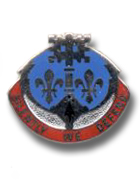 502nd ASA Group
DUI
502nd ASA Group
DUI |
||||||||||||||||||
| 1971 - 1977 | ||||||||||||||||||
| On May 3 1971,
the 502nd ASA Group was activated in
Augsburg. At this time, the 502nd ASA Gp comprised the following units: |
||||||||||||||||||
|
||||||||||||||||||
| Between
1971 and 1974, the Group grew in size as additional units were added
to its span of control: |
||||||||||||||||||
| In 1974, the
2nd EW Co was split into two units: On 1 July 1974, the 851st ASA Co (DS) was activated in Germany and assigned the mission of supporting the 3rd Inf Div. That same year, the 374th ASA Co was redesignated 856th ASA Co (Michael Bks, Frankfurt-Höchst) and assigned to the 3rd Armd Div. (Webmaster Note: Another source states that the 2nd EW Co, Flak Ksn, Augsburg became the 202nd ASA Co and moved to Katterbach (1st Armd Div) sometime around 1974-1975. Can anybody provide information on this? - see response from Larry Mellgren) In 1975, the 302d ASA Bn and the 415th ASA Co (Direct Support) (supported 8th Inf Div) joined the Group. The 302nd ASA Bn (Corps) was react at Frankfurt, effective 21 Dec 1975, and assigned to the 502nd ASA Gp in support of V Corps. The 415th ASA Co had been activated in July 1974 at Augbsurg (Flak Ksn) and was later moved to Idar Oberstein which was closer to the 8th Inf Div, the unit that the 415th supported. By December 1976, the Group had also assumed control over the 330th ASA Co (Avn). The 330th ASA Co (EW) had been activated on 30 Sep 1973 to operate the GUARDRAIL system as a theater level asset. Detachment 1 of the 330th ASA Co was deployed to Kitzingen AAF (Sept 1973 - 1975) and later at Stuttgart AAF (1975). The detachment flew the RV-1C's (QUICKLOOK I). (Webmaster Note: COMINT aircraft were first used in Europe in the 1971 REFORGER I exercise. The RU-21G GUARDRAIL I was equipped only for intercept missions. The GUARDRAIL II (RU-21E) was deployed the following year and added a DF capability.) In January 1977, the 502d ASA Group was reassigned to HQ US Army, Europe. This was a result of the deactivation of the Army Security Agency, Europe. The Group downsized shortly thereafter as the 302d (on 1 Jan 1977) and 307th Battalions were reassigned to V and VII Corps and the direct support companies reverted to divisional control. The Group was reorganized and redesignated on 1 Oct 1981 as Headquarters and Headquarters Company, 502nd Army Security Agency Battalion. |
||||||||||||||||||
| CORRECTION: (Source: Email from Mark L. Streeter) I was assigned to the 502 ASA Group Augsburg in 1976. I noticed in your web page, which is absolutely wonderful, the 415th ASA Co. as being re-assigned in 1975. I may have found an error. I was assigned to the 415th ASA Co., 502 ASA Group which was not re-assigned to the 8th Infantry Division until 1976. I was part of the move north with our new home in Idar Oberstein, Germany. Webmaster Note: Could it be that the 415th was assigned or attached to the 502nd in 1975 (with the mission of providing DS support to the 8th ID), but then reassigned directly to the 8th ID in 1976? (Source: Email from Donald Nesheim (MOS 983A USASA 1957-77) From the part of the Web page on 502nd -- "By December 1976, the Group had also assumed control over the 330th ASA Co (Avn). The 330th ASA Co (EW) had been activated on 30 Sep 1973 to operate the GUARDRAIL system as a theater level asset. Detachment 1 of the 330th ASA Co was deployed to Kitzingen AAF (Sept 1973 - 1975) and later at Stuttgart AAF (1975). The detachment flew the RV-1C's (QUICKLOOK I). (Webmaster Note: COMINT aircraft were first used in Europe in the 1971 REFORGER I exercise. The RU-21G GUARDRAIL I was equipped only for intercept missions. The GUARDRAIL II (RU-21E) was deployed the following year and added a DF capability.)" Detachment 1 of the 330th ASA Co (AVN) was deployed to Kitzingen AAF in June 1974 and moved to Stuttgart in June 1975. The 330th was a 502nd Group unit as soon as it came in country. I was the OIC of Det at Kitzingen and arrived in late June 1974. There was a small advanced party there under SSG Kiser when I arrived. The RV-1C's (tail numbers 68-15964 & 68-15965) had been flown from the US to Germany but the unit pilots were not in country yet. Capt Lawrence arrived a few weeks after I did and assumed command upon his arrival. He was a Mohawk IP pilot and trained the other pilots on border flight procedures when they arrived. CW4 Donald Nesheim, USA Ret MOS 983A (USASA 1957-1977) (Source: Email from James Kiser, Det 1, 330th ASA Co (Avn)) The dates of Det 1 330th ASA Co are a little off. We actually deployed to Kitzingen AAF in Jun/Jul of 1974. The activation order was dated sometime in Jun 74. The personnel and equipment arrived piecemeal and I don't think we were declared operational until late Aug 74. We moved to Stuttgart AAF in June of 75. Det 1 became part of the 73rd MICAS in Sep 1977. Quick Look I was replaced by Quick Look II in Sep/Oct 1978. I was NCOIC and OPSNCO for Det 1. Click on the following linkis to see more on the 330th ASA Co (EW) |
||||||||||||||||||
| 1973 | ||||||||||||||||||
| (Source: Email from Jim Volstadt) | ||||||||||||||||||
| Jim Volstadt served with HHC, 502nd ASA Group in Augsburg from April 1973 until 1975 when he pcs'ed to Field Station San Antonio. Initially, he was billeted in Bldg #124 (near the Post Chapel) at Sheridan Kaserne. Jim provided the ID for Building M at Flak Kaserne (see map) as the former MARS station. He was one of the operators in the mid-1970s. |
||||||||||||||||||
| (Source: Email from Larry Hudacek) | ||||||||||||||||||
| I was browsing the web when I happened upon your listing of Flak Kaserne, my old stomping grounds. I was a Military Policeman assigned to HHC 502d ASA GP in 1973-1974. I spent 2 years in Augsburg before being reassigned to Garmisch. As a military policeman assigned to an ASA (Army Security Agency) unit, our main duties were manning the gate at the kaserne entrance, patrolling the kaserne and guarding the S-3 (Plans, Operations and Training) office 7 X 24. We also responded to incidents at the Flak EM Club, in an unofficial and first response manner. Our main function was to provide physical security to the ASA mission. The “real” law enforcement functions were handled by the 21st MP Det and Co C, 385th MP BN located on Reese Barracks. Many of the MP’s on Flak kaserne knew many of the MP’s on Reese Barracks. We often compared notes. We fared much better (nicer living areas, a lower profile kaserne and a better work schedule. ASA just wasn’t the “Real Army”. The mission was more technical and less soldier oriented. I remember the 409th ASA Co being formed, but prior to that, the subordinate units were: This all probably changed after the 502d ASA Group reorganization was complete. I believe that the 30th Gen. Hosp. medics and other enlisted personnel were billeted in Bldg. 214. The APO (as I remember it) was located in the basement of the main hospital bldg. Located in the rightmost area of bldg. 210 was the “Lifer’s Lounge” with a Thor Brau beer sign hanging above the door. Hasen Brau beer was served in the EM Club. Might the 236th Medical Detachment (Medevac) been located in bldg.. 225? Might the MARS Station been located in bldg. 219? Was the library Located in bldg. 217? Just thought I would pass on some recollections of my “Flak Experience”. The other ASA unit in Augsburg was “Field Station Augsburg”. Their military police staffed their headquarters office on Flak Kaserne and provided security at the large antenna site at Gablingen kaserne. ADDITIONAL INFORMATION I contacted an Army buddy of mine who spent a number of years at Reese Kaserne. From his reply I gather that my knowledge of that area is better than his! What I do remember is that Bldg. #2 (on the northern part of the Reese map, along Langemarkstr.) was occupied by Co C 385th MP BN, which later became the 218th MP CO. The 8094th CLG (Civilian Labor Group) was located in the same building. The 229th S & S Co was located in Bldg. #1 (due east of Bldg. #2). The 1/36 FA and HQ VII Corps Artillery were also located at Reese, exact locations unknown. I also lived for 1 year as a civilian in Munich – Giesing, which was close to McGraw Kaserne. The impressive Reichszeugmeisterei building "Reichszeugmeisterei" is currently in use by the German Police. I passed by the front of the kaserne several years ago and observed shadows on a building that spelled “University of Maryland”. The raised letters had long been removed, but the vestiges still remained. A website with which you may already be familiar (link) contains many details about the former McGraw Kaserne. |
||||||||||||||||||
|
|
||||||||||||||||||

